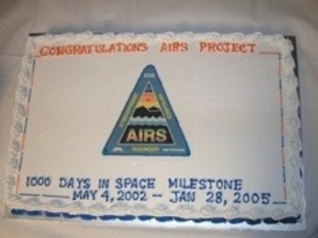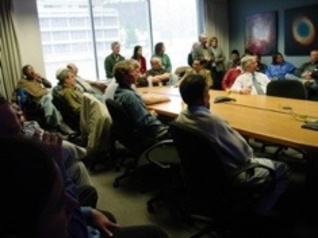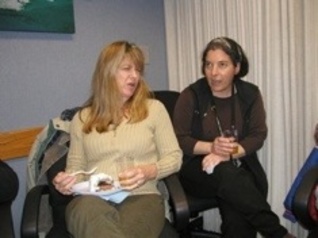News | January 28, 2005
AIRS Marks 1000 Days in Space

Two-and-a-half years of nearly flawless operation and outstanding results
January 28th, 2005 marked the anniversary of the 1000th day in space for the Atmospheric Infrared Sounder, NASA's new high spectral resolution infrared instrument for measuring atmospheric temperature, water vapor and trace gases. The AIRS instrument suite, part of NASA's Aqua Earth Observing System satellite, was launched on May 4, 2002 from Vandenberg Air Force Base, Calif., on a Delta II Launch Vehicle into a sun-synchronous polar orbit. The AIRS Project has had an outstanding two and a half plus years, achieving nearly flawless operation of the AIRS and Advanced Microwave Sounding Unit (AMSU) instruments and demonstrating critical science objectives and a significant impact on weather forecasting.
While the AIRS Team celebrated with cake and sparkling apple cider, AIRS Project Manager Tom Pagano congratulated the JPL team for their efforts. "We're not here to celebrate the instrument, but to acknowledge your efforts in the instrument development, calibration, operations, algorithm and software development and validation, which has made the Project a success". The AIRS Project has met all of its objectives to date. The primary products from AIRS are temperature and water vapor profiles in three dimensions. "Thirty years ago, scientists lead by our very own Dr. Mous Chahine, predicted that high spectral resolution infrared measurements could provide temperature and water vapor profiles with radiosonde accuracy. Here we are today having validated AIRS products, called "satellite-sondes" which are as good or better than radiosondes and are produced on a global scale every day in the presence of clouds." Mous Chahine, AIRS Science Team Leader, said of the AIRS instrument, "It is the most accurate sounder ever flown in space... it is just perfect!"
In a recent accomplishment highlighted by Pagano, Dr. John LeMarshall, Director of the NOAA-NASA-U.S. Navy-U.S. Air Force Joint Center for Satellite Data Assimilation (JCSDA) assimilated AIRS data into the operational National Centers for Environmental Prediction (NCEP) forecast models for the first time. "There were several skeptics who did not believe infrared could improve forecasts. They were pleasantly surprised to see a forecast improvement of 6 hours on the 5 day forecast; this accomplishment alone has made the AIRS Project worth the government investment." The impact is equivalent to several years improvement in the models (without new data), and one of the best improvements they have seen in the last 10 years. Further improvement is expected as the JCSDA assimilates more AIRS data than just the clear regions.
Not only is AIRS making an impact in weather forecasting, it's becoming a precise tool for climate modelers. Water vapor is by far the most important greenhouse gas accounting for more than 50% of the warming induced by all greenhouse gases combined. An increase in upper atmospheric water vapor will accelerate global warming. AIRS scientists are studying the global variations of upper atmospheric water vapor to determine if it is increasing.
Scientists on the AIRS Project have also demonstrated the instrument's sensitivity to key greenhouse gases including Carbon Dioxide, Carbon Monoxide and Methane. "AIRS provides a comprehensive and self consistent set of greenhouse gas measurements from a single instrument, and the instrument stability makes these products well suited for climate studies". "Our work is just beginning", Chahine said. "The task of validating the upper atmospheric water vapor and greenhouse gas products is new territory complicated by the small number of "truth" data sets".
The AIRS Project is also supporting the National Polar Orbiting Environmental Satellite System (NPOESS) and the Geostationary Operational Environmental Satellite (GOES-R) (spell these out) programs with technical support. Tom Pagano said "NASA and NOAA are coming to JPL to ask for advice on how to develop and validate their future infrared sounding instruments on these programs. We are pleased to give them our advice and look forward to merging their data sets with ours to produce climate data records that we can use for climate studies at JPL."









